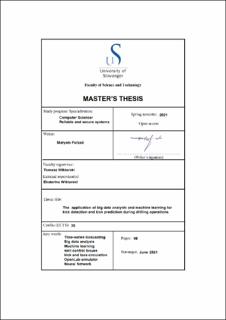| dc.description.abstract | Drilling operations for oil and gas extraction is a complex and risky process. Workers are not able to start the drilling operations unless they carefully accomplish some pre-drilling activities such as choosing a proper site wisely and arranging the rig equipment. But no matter how much caution the drilling setup is done, hazards and unplanned events are likely to happen anyway. Kick is a down-hole phenomenon that occurs when an uncontrolled amount of formation fluid flows into the wellbore when formation pressure is more than hydrostatic and fractional pressure in the wellbore. There are several procedures when experiencing a kick to minimize the danger. However, small kicks are probable to turn into catastrophic blowouts due to improper handling.
Managing drilling hazards is a globally crucial task in the oil and gas industry to prevent incurable consequences such as fatal accidents, devastating injuries, loss and huge damages to the rig assets, and destructive influence on the environment. Due to the complexity of downhole conditions, finding the right and perfect way to reach the desired depth fast is extremely challenging. Drilling operations are directly accompanied by dealing with a huge volume of data. Therefore, it has become a major concern for many oil and gas companies to manage the datasets obtained from rigs to gain valuable operational insight. Data analysis in this area assists in effective decision-making in different activities while balancing the operational complexities with the associated risks.
Performance enhancement is the main wish in the oil and gas industry. However, traditional data preparation and analysis methods are not sufficiently capable of rapid information extraction and clear visualization of big complicated datasets. Data mining can make a big difference in operational performance by exploring an existing massive dataset to uncover unknown trends and identify relationships and anomalies in the dataset. Then, with machine learning, computers are able to learn the patterns by developing fast and efficient algorithms to make predictions about new datasets.
The main focus of this thesis is on mitigating hazardous events in drilling operations by enabling the identification and prediction of kicks ahead of time. In this study, firstly, the raw synthetic data is generated with the OpenLab drilling simulator created by NORCE. During drilling a well a large number of parameters are being monitored and saved which are processed through data cleaning, feature scaling, outlier detection, data labeling, and dataset splitting. Feature engineering and feature selection are the next vital steps in the dataset preparation phase to decide on which feature combinations are suitable to be applied. The data samples are proportionally split into train set and test set to be measured by some evaluation metrics for accuracy, precision, recall, and F1-score estimation. Then, Machine Learning models are created and developed to train the data. Finally, the models are going to be evaluated to optimize the whole process of kick identification and prediction. The proposed model can potentially be improved in terms of accuracy and efficiency. | |
